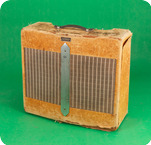Very Good condition, 7,5/10, tranny is marked EIA606-235, speaker has a code 064121 and is stamped 506111-2, from Wikipedia: In 1982, in order to combat its decreasing amp sales, which at that time was around 10,000 units per year, Fender hired Paul Rivera (of Rivera Amplifiers) as Marketing Director to specify and help design a whole new range of amplifiers to meet the contemporary requirements of musicians. Even though he did not personally create the new designs, his direction of the engineering team, headed by Ed Jahns and Bill Hughes, resulted in some legendary amps, including the Super Champ. Featuring a push-pull output, 10 speaker, and spring reverb, as well as some new circuitry; master volume, a switchable extra gain stage for a lead effect, and a mid-boost switch. The Super Champ utilized 1x 12AX7 for the first and second stage preamp, a 1x 12AT7 for spring reverb driver tube, whilst the three sections of the triple-triode 6C10 compactron serve as a recovery for the spring reverb, as a driver for the phase inverter, and as a split-load phase inverter. When the volume knob is pulled, some signal from the 12AT7 reverb driver is re-routed, resulting in higher gain. An optional two-button foot-switch allowed for gain switching and reverb on/off. Two 6V6GT power tubes provide it with 18 RMS watts. The cabinet was finished in black Tolex, with a black faceplate and silver grille cloth. The speaker was offered either with the standard Fender Blue Label, or optionally with a Fender-branded Electro-Voice EVI-10. Additionally, 100 Super Champ cabinets made of oak, fitted with EVI-10, having brown/champagne faceplate and knobs, and a special grille cloth were offered as part of the Super Pro Series. The Super Champ was sold until 1986. Along with the Concert amp, it was the last tube amp to be made by Fender under CBS ownership, and the last to be made at Fullerton.



























